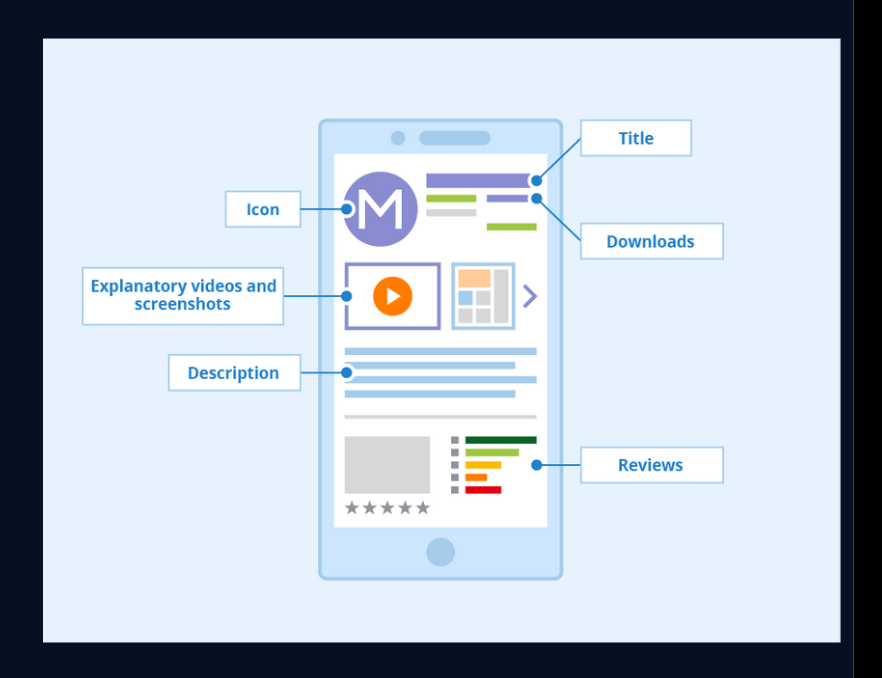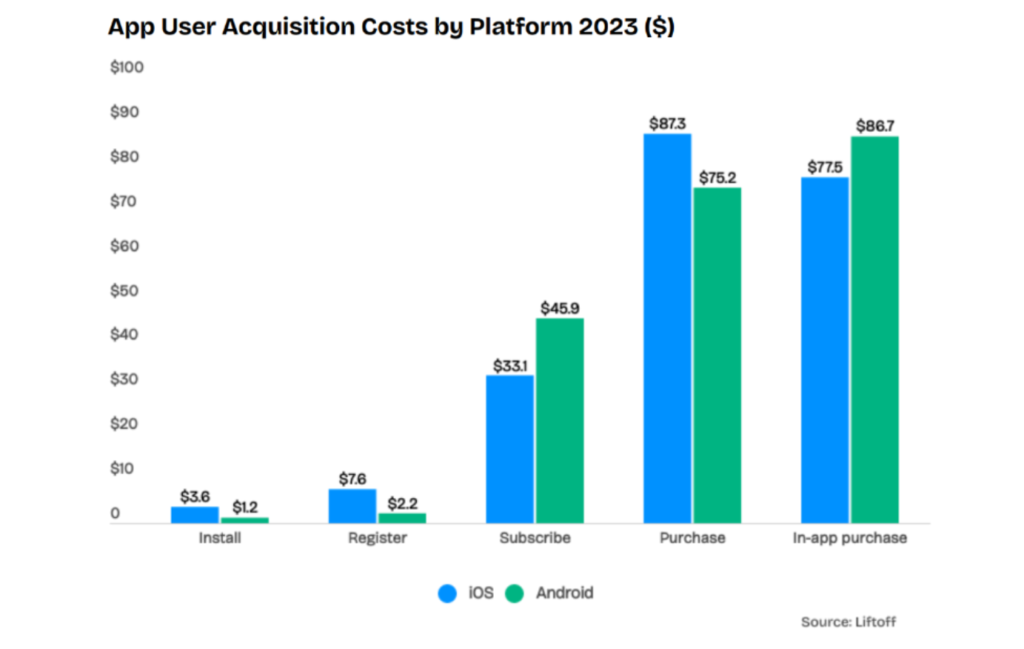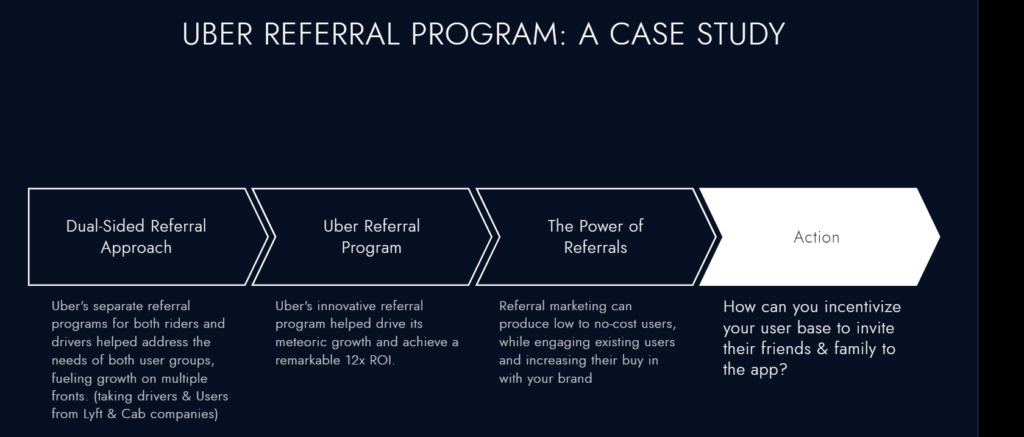In the dynamic world of mobile app development, having a great app is just the beginning. To ensure your app reaches its intended audience and thrives in a competitive market, effective mobile app marketing is essential. This comprehensive guide will explore key strategies and insights, focusing on app store optimization (ASO), paid user acquisition (UA), and product-led growth, tailored for founders looking to launch and grow their apps successfully.
What is Mobile App Marketing?
Mobile app marketing is a multifaceted approach aimed at driving user acquisition, engagement, and retention. It encompasses a range of strategies designed to increase visibility, attract new users, and ensure your app stands out in a crowded marketplace. Here’s why mobile app marketing is crucial:
- Visibility and Discovery: Proper marketing ensures your app is discoverable on app stores, enhancing its chances of being downloaded.
- User Acquisition Cost Efficiency: Effective marketing reduces the cost of acquiring new users, maximizing your return on investment.
- Building Trust and Credibility: A well-executed marketing strategy builds credibility through positive reviews and high ratings, fostering trust among potential users.
- Sustained Growth and Engagement: Continuous marketing efforts keep your app relevant, encouraging user engagement and long-term growth.
Key Strategies for Successful Mobile App Marketing
- App Store Optimization (ASO)
What is ASO?
App Store Optimization (ASO) is the process of optimizing your app’s listing on app stores to improve its visibility and ranking. It involves optimizing various elements such as keywords, app title, description, screenshots, reviews, app logo, localization, custom product pages, and more to enhance discoverability and attract more organic downloads.
Why ASO Matters
- Increased Visibility: Helps your app appear in relevant searches, making it easier for users to find.
- Reduced Acquisition Costs: Organic downloads through ASO are cost-effective compared to paid acquisition.
- Higher Conversion Rates: A well-optimized app store page converts more visitors into users by clearly communicating the app’s value proposition.

Key ASO Components
- Keywords
- Metadata Optimization
- Ratings and Reviews
- App Logo
- Screenshots and Previews
- Custom Product Pages
- Localization
- App Store Differences
Detailed Subtopics for ASO
Keywords
Conducting Keyword Research
Keywords are fundamental to ASO. Conducting thorough keyword research involves understanding what terms potential users are searching for and ensuring these keywords are included in your app’s metadata. Use tools like Google Keyword Planner, App Radar, and Sensor Tower to identify high-volume, low-competition keywords that are relevant to your app.
Strategies for Keyword Selection
- Brainstorming: Start with a list of potential keywords related to your app. Consider all possible terms users might use to find an app like yours.
- Competitor Analysis: Analyze competitors’ apps to see which keywords they are ranking for and identify gaps where your app can stand out.
- User Intent: Focus on keywords that match the intent of your target audience. Consider what problems your app solves and what terms users might search for when looking for solutions.
Metadata Optimization
Optimizing App Title, Subtitle, and Description
Your app’s metadata, including the title, subtitle, and description, plays a critical role in ASO. These elements should be optimized with targeted keywords to improve search rankings.
- App Title: Incorporate primary keywords while keeping the title concise and descriptive.
- Subtitle (iOS): Use this space to include secondary keywords and highlight unique selling points.
- Description: Write a compelling description that includes relevant keywords naturally. Ensure it clearly explains the app’s features and benefits.
Ratings and Reviews
Importance of Ratings and Reviews
Ratings and reviews significantly impact your app’s ranking and credibility. High ratings and positive reviews build trust with potential users and signal to app store algorithms that your app is valuable.
Strategies to Encourage Positive Reviews
- Prompt Users: Use in-app prompts to ask satisfied users for reviews.
- Respond to Feedback: Engage with users by responding to reviews, showing that you value their feedback.
- Incentivize Reviews: Consider offering incentives for users to leave reviews, such as unlocking premium features or providing discounts.
App Logo
Designing an Eye-Catching App Logo
Your app logo is the first visual element users see. It should be attractive, memorable, and represent your brand effectively.
Best Practices for App Logo Design
- Simplicity: Keep the design simple yet distinctive.
- Relevance: Ensure the logo reflects the app’s purpose and theme.
- Scalability: The logo should look good at different sizes, from app store icons to in-app branding.
Screenshots and Previews
Creating Effective Screenshots and Previews
Screenshots and preview videos are crucial for showcasing your app’s features and benefits. They should be visually appealing and provide a clear understanding of what the app offers.
Strategies for Optimizing Visuals
- Highlight Key Features: Use screenshots to highlight the most important features and benefits.
- Use Captions: Add captions to explain what users are seeing in each screenshot.
- Preview Video: Create a short, engaging video that demonstrates the app’s functionality and value proposition.
Custom Product Pages
Utilizing Custom Product Pages for A/B Testing
Custom product pages allow you to test different elements, such as screenshots, descriptions, and icons, to see what resonates most with your users.
Best Practices for A/B Testing
- Set Clear Goals: Define what you want to learn from the A/B tests.
- Test One Element at a Time: Focus on one variable to understand its impact.
- Analyze Results: Use data to make informed decisions about which elements to implement.
Localization
Optimizing Your App for Different Regions
Localization involves adapting your app’s metadata for different regions to ensure it is discoverable in multiple languages and cultures.
Strategies for Effective Localization
- Translate Metadata: Ensure your app title, subtitle, and description are translated accurately.
- Localize Keywords: Research keywords for each target region to include relevant local terms.
- Cultural Adaptation: Make sure the app’s content and visuals are culturally appropriate for each region.
App Store Differences
Understanding iOS and Google Play Store Differences
Both the iOS App Store and Google Play Store have unique ranking algorithms and requirements. Understanding these differences is crucial for effective ASO.
iOS App Store:
- App Title: 30-character limit. Optimize with primary keywords.
- Subtitle: 30-character limit. Use for secondary keywords and unique selling points.
- Description: Not indexed for search, but important for user engagement.
- Hidden Keyword Field: 100 characters. Include additional relevant keywords.
- Updates: Frequent updates help maintain and improve rankings.
Google Play Store:
- App Title: 50-character limit. Optimize with primary keywords.
- Short Description: 80-character limit. Highlight key features and benefits.
- Long Description: 4,000 characters. Indexed for search; include primary and secondary keywords naturally.
- Updates: Frequent updates and user engagement are crucial for rankings.
Example: Effective ASO Implementation
Imagine a meditation app called “ZenMind.” To optimize ZenMind’s ASO, you start with a comprehensive keyword research process. You identify high-volume, low-competition keywords such as “mindfulness,” “relaxation,” and “guided meditation.” You then update ZenMind’s app title to “ZenMind: Mindfulness & Guided Meditation” and its subtitle to “Relaxation Techniques for a Peaceful Mind.”
Next, you create visually appealing screenshots that highlight key features like guided sessions, progress tracking, and relaxation techniques. To boost initial ratings and reviews, you encourage early users to leave positive feedback by integrating prompts within the app. Additionally, you design an eye-catching app logo that represents the calm and serenity associated with meditation. To cater to international users, you localize your app’s metadata for different regions, ensuring ZenMind is discoverable in multiple languages.
Tools for ASO
- App Radar: Provides competitor analytics and keyword insights.
- Sensor Tower: Offers comprehensive app store data and competitive research.
- App Tweak: Focuses on keyword optimization and performance tracking.
- Paid User Acquisition (UA)
What is Paid UA?
Paid User Acquisition involves investing in advertising campaigns across various channels to drive traffic to your app. This includes social media ads, search ads, and display ads, designed to attract and convert users.
Effective Paid UA Strategies
- Targeted Advertising: Use platforms like Facebook Ads, Google Ads, and Apple Search Ads to target specific demographics and user behaviors.
- Budget Management: Allocate your budget effectively, testing different ad creatives and targeting options to find the most cost-effective strategies.
- Campaign Optimization: Continuously monitor and optimize your campaigns based on performance metrics such as click-through rates (CTR), conversion rates, and cost per install (CPI).
Best Practices for Paid UA
- Create Engaging Ad Creatives: Use high-quality images, videos, and compelling ad copy to grab users’ attention.
- Segment Your Audience: Use audience segmentation to tailor your messages to different user groups, increasing relevance and conversion rates.
- Leverage Analytics: Use tools like Firebase, Adjust, or AppsFlyer to track user behavior, measure campaign performance, and optimize your strategy based on data-driven insights.

Apple Search Ad Strategies
What are Apple Search Ads?
Apple Search Ads allow you to promote your app directly within the App Store search results, giving you high visibility and a competitive edge for relevant keywords.
Effective Apple Search Ad Strategies
- ASO Boosting Strategy:
- Initial Investment: Start with a substantial ad budget (e.g., $10,000/month) for the first three months to boost your app’s visibility and rankings.
- Sustained Effort: After the initial phase, reduce the budget (e.g., $2,500/month) to maintain the achieved rankings and visibility.
- Goal: This strategy aims to artificially boost your organic rankings by showing Apple that your app is popular and engaging.
- Competitor Campaigns:
- Identify Competitors: Conduct keyword research to identify branded keywords and long-tail combinations used by competitors.
- Target Competitor Keywords: Set up campaigns targeting these competitor keywords to capture traffic that would otherwise go to competing apps.
- General Category Campaigns:
- Keyword Research: Use keyword research to identify high-volume, relevant terms for your app category.
- Bidding Strategy: Bid on these high-volume keywords to gain visibility and attract more users.
Example: Successful Paid UA Campaign
Consider a fitness app called “FitLife.” To run an effective paid UA campaign, you start by identifying your target audience: health-conscious individuals aged 18-35. You decide to use Facebook and Instagram for targeted advertising, creating engaging ad creatives that showcase the app’s unique features, such as personalized workout plans and nutrition tracking. You segment your audience by interests, behaviors, and demographics, tailoring your messages to resonate with each segment. Using analytics tools like Adjust, you track user behavior and measure campaign performance, continuously optimizing your ads to improve conversion rates and reduce acquisition costs.
Product-Led Growth (PLG)
What is Product-Led Growth?
Product-Led Growth is a strategy where the product itself drives user acquisition, expansion, and retention. It focuses on creating a product experience that naturally encourages users to invite others, upgrade to premium features, and engage with the app’s core functionality.
Key Elements of PLG
- Freemium Model: Offer a free version of your app with essential features, encouraging users to upgrade to a paid plan for advanced functionalities.
- User Experience Design: Design an intuitive and seamless user experience that keeps users engaged and satisfied. Focus on reducing friction in the user journey and providing value at every touchpoint.
- Product-Market Fit: Validate your product idea and ensure it meets the needs and expectations of your target audience. Use feedback and data to iterate and improve the product continuously.
- Continuous Improvement: Track user behavior and feedback to identify areas for enhancement. Regularly update your app to address issues, add new features, and keep up with market trends.
- Virality and Referrals: Implement features that encourage users to invite friends, share content, or refer others to the app. Examples include referral bonuses, social sharing options, and invite codes.
Case Study: Uber’s Referral Program

Overview
Uber’s referral program is a prime example of a successful product-led growth strategy. By incentivizing both riders and drivers to refer new users, Uber rapidly expanded its user base and established itself as a leading ride-hailing app.
How Uber’s Referral Program Worked
- Dual-Sided Referral: Uber offered incentives to both riders and drivers. Riders received free or discounted rides for referring new users, while drivers received bonuses for bringing in new drivers.
- In-App Integration: The referral program was seamlessly integrated into the app, making it easy for users to share referral codes and track their rewards.
- Personalized Incentives: The incentives were tailored to each market and user segment, ensuring they were attractive and relevant.
Impact
- Rapid Growth: The referral program played a crucial role in Uber’s rapid expansion, helping it achieve a 12x return on investment (ROI).
- User Engagement: By rewarding users for referrals, Uber increased user engagement and loyalty.
- Low-Cost Acquisition: The program generated low-cost user acquisitions, as referred users were more likely to convert and stay active compared to those acquired through other channels.
Pirate Metrics (AARRR Framework)
What is the AARRR Framework?
The AARRR framework, also known as Pirate Metrics, is a comprehensive model for tracking and optimizing key stages of the user lifecycle. It stands for Acquisition, Activation, Retention, Referral, and Revenue.
Breakdown of AARRR Metrics
- Acquisition:
- Definition: How users find your app.
- Metrics: Downloads, traffic sources, cost per install (CPI).
- Example: A meditation app tracks where its downloads are coming from, such as search ads, social media campaigns, or organic searches.
- Activation:
- Definition: Initial user experience and engagement.
- Metrics: Onboarding completion rates, initial session length, feature usage.
- Example: The meditation app measures how many users complete the onboarding process and engage with their first guided meditation session.
- Retention:
- Definition: Keeping users engaged over time.
- Metrics: Daily active users (DAU), monthly active users (MAU), churn rate.
- Example: The meditation app tracks how often users return to the app for new sessions and their overall retention rate over 30, 60, and 90 days.
- Referral:
- Definition: Users inviting others to the app.
- Metrics: Referral rate, number of invites sent, conversion rate of referrals.
- Example: The app incentivizes users to invite friends by offering free premium features for successful referrals, tracking how many new users join through these invitations.
- Revenue:
- Definition: Monetizing your app.
- Metrics: Average revenue per user (ARPU), lifetime value (LTV), conversion rate from free to paid users.
- Example: The app measures how many free users convert to premium subscriptions and tracks the average revenue generated per user.
Data and Tech Stack
Tracking and Analyzing Data
Accurate data tracking and analysis are crucial for implementing and optimizing PLG strategies. Here’s a look at the essential tools for building a robust data tech stack:
- Product Analytics:
- Tools: Firebase, Mixpanel, Amplitude.
- Purpose: Track user interactions, identify drop-off points, and analyze user behavior within the app.
- Attribution Tracking:
- Tools: Adjust, AppsFlyer.
- Purpose: Understand where your users are coming from, measure the effectiveness of different acquisition channels, and attribute conversions accurately.
- In-App Engagement Tools:
- Tools: Braze, Leanplum.
- Purpose: Send personalized push notifications, in-app messages, and email campaigns to engage and retain users.
- App Store Analytics:
- Tools: App Annie, Sensor Tower.
- Purpose: Monitor app store performance, track rankings, reviews, and competitive insights.
- Customer Feedback:
- Tools: SurveyMonkey, Typeform.
- Purpose: Gather user feedback to inform product improvements and validate feature ideas.
Implementing the Tech Stack
To implement an effective tech stack, follow these steps:
- Define Your Goals: Determine what you need to track and why. This will guide your choice of tools.
- Select the Right Tools: Choose tools that integrate well with each other and fit your specific needs.
- Set Up Proper Tracking: Ensure accurate tracking by setting up events, user properties, and funnels correctly.
- Analyze Data Regularly: Regularly review and analyze data to make informed decisions and optimize your strategies.
- Iterate and Improve: Use insights from data analysis to iterate on your product and marketing strategies, ensuring continuous improvement
Apart from App Store Optimization (ASO), Paid User Acquisition (UA), and Product-Led Growth (PLG), consider these additional marketing strategies for your mobile app:
Organic Content Marketing
What is Organic Content Marketing? Organic content marketing involves creating and sharing valuable content on your website and social media channels to attract and engage your target audience, building brand awareness and driving traffic.
Effective Strategies
- Blogging: Create SEO-optimized blog posts related to your app’s niche.
- Social Media Engagement: Share content on platforms like Instagram, Facebook, and LinkedIn. Use hashtags and engage with followers.
- Content Repurposing: Transform blog posts into videos, infographics, podcasts, or social media snippets.
Influencer Marketing
What is Influencer Marketing? Influencer marketing involves partnering with influencers who have a significant following within your target demographic to promote your app.
How to Execute
- Identify Relevant Influencers: Use tools like Influencity or Upfluence.
- Build Relationships: Engage with influencers through personalized messages and collaborations.
- Track Performance: Use tracking links and promo codes to measure campaign effectiveness.
Traditional Marketing
What is Traditional Marketing? Traditional marketing includes offline and online methods like events and sponsorships,webinars and conferences which can still play a vital role in building brand awareness..
Direct B2B Sales Approach
What is Direct B2B Sales? Direct B2B sales involve targeting other businesses as potential customers, ideal for apps designed for enterprise use or industry-specific solutions.
Effective mobile app marketing involves mastering ASO, leveraging paid user acquisition, and implementing product-led growth strategies. By focusing on these key areas, along with other marketing strategies, you can ensure your app reaches its intended audience, drives user engagement, and achieves long-term success. Use the insights and best practices outlined in this guide to optimise your app marketing efforts and build a thriving app that stands out in a competitive marketplace.